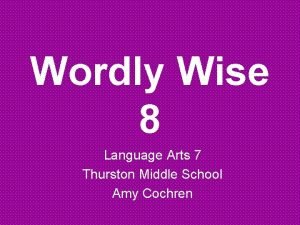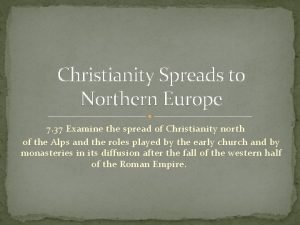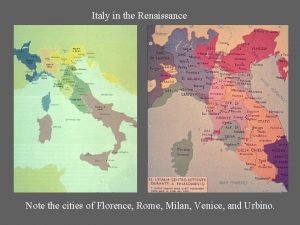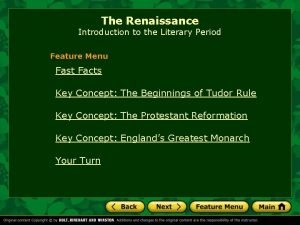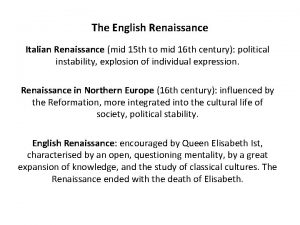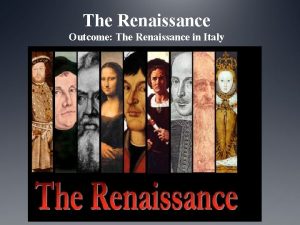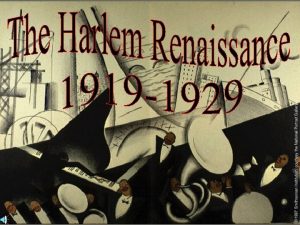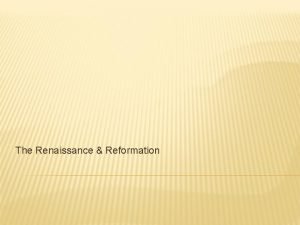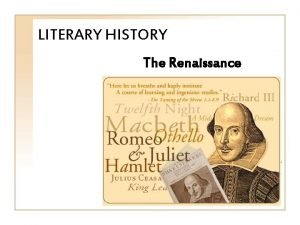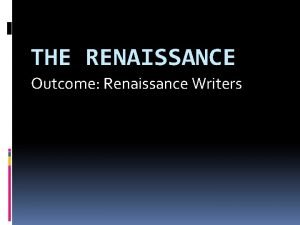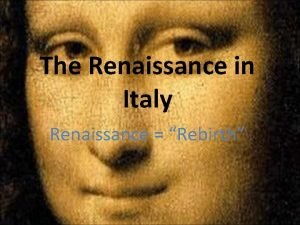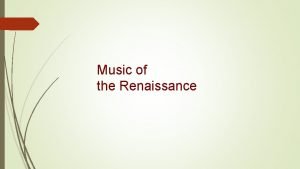Women during the Renaissance Did Women Have a













- Slides: 13

Women during the Renaissance

Did Women Have a Renaissance? • Joan Kelly (historian): Did Women have a Renaissance? (1977) • 1. Kelly asserts that middle class (bourgeois) women especially suffered a marked decline in their status along with that of noble women during the Italian Renaissance • 2. Middle class women were exclusively relegated to the private sphere while men monopolized political and economic issues in the public sphere. • 3. Sexual chastity was essential for both women of the nobility and the bourgeoisie; a double-standard existed as chastity was not expected of men • 4. Medieval feudalism permitted homage to female vassals but in Renaissance Italy feudalism came to be replaced by powerful city-states. Thus, the political power of women in many cases vanished. • Noble women thus experienced a state of almost universal dependence on her family and husband

Wealthy Women • Querelles des Femmes (“The Problem of Women”) – new debate emerged over women’s nature and their proper role in society (starting with Pisan in the 14 th century) the debate continued throughout history • Increased access to education • were to be “ornaments” to their husbands

• Christine de Pisan (1363? -1434? ) • The City of Ladies (1405); The Book of Three Virtues • Chronicle of accomplishments of great women of history. • Renaissance woman’s survival manual. • Perhaps Europe’s first feminist • Extremely well-educated in France. “Just as women’s bodies are softer than men’s, so their understanding is sharper. ”

• Isabella d’Este (1474 -1539): “First Lady” of the Renaissance • Set an example for women to break away from their traditional roles as mere ornaments to their husbands • Ruled Mantua after husband died • She and her siblings were well educated • Big patron of the arts • Founded a school for young women • Wrote over 2000 letters that provide a window into politics and courtly life at that time.

• Artemesia Gentileschi (1593 -1652) (considered a Baroque painter) • Perhaps the first female artist to gain recognition in the post-Renaissance era. • First woman to paint historical and religious scenes: e. g. her series of “Judith” paintings • Female artists at this time were largely consigned to portrait painting & imitative poses

Money and Business increased opportunity • Manifested into… • • Adornment Increased dowries Emancipation from care of children Emancipation from household drudgery • With money women entered into the lives of men as they became • Painters • Musicians • Writers • The artistic world was greatly concerned with the pursuit of love

Marriage • Based on economic considerations, not love • Dowries extremely important in wealthy families • Virtue was a marketable commodity • Women secluded from birth until marriage • Taught by women or priests • Kept under very close supervision • Women seen as property that could raise the social stature of a family, seal alliances (either princely or mercantile)

Marriage • Average for women: • < 20 (for men it was mid-late 20 s) • 12 was common, 15 was late, and 17 was a catastrophe • Class issues: rich tend to marry earlier than middle classes, and poor tend to marry earlier too • In Italy, the age gap between husbands and wives was much larger than in Northern Europe • Increase in infanticide and abandonment among the poor

Marriage • Marriage demanded the biggest celebration that could be afforded • • • Using canals of Venice for a parade Buildings adorned with rare tapestries Bonfires Fireworks Balls and banquets were arranged The couple was serenaded by hired musicians Painters immortalized the couple Poets wrote sonnets and odes in their honor Playwrights wrote plays showing the couple as Greek heroes Publically put to bed for all to see – end of the contract was in the marriage bed

• Divorce available in certain areas (still very limited) compared to Middle Ages where divorce was non-existent • Women were to make themselves pleasing to the man (Castiglione)- only upper classes • Sexual double-standard: women were to remain chaste until marriage; men were permitted to “sow their wild oats. ” • More prostitution than in Middle Ages • Rape not considered a serious crime

• Most women toiled at home, on looms, or in the field along with their men • It was in Church, that they eased their sorrows • Most women knew little of the fine ideals of the time • Lives dedicated to husbands, children, and proper social behavior

• Women were to be: • Prudent, pius, ignore vanities • But they did possess a modest elegance, unlike medieval women • Women could dress finer, eat better, wear jewelry and entertain • But it was unusual for women to be very learned
 Did women have a renaissance
Did women have a renaissance Why did the fleeing women have trouble breathing
Why did the fleeing women have trouble breathing Causes of renaissance
Causes of renaissance Italian renaissance vs northern renaissance venn diagram
Italian renaissance vs northern renaissance venn diagram The renaissance outcome renaissance painters/sculptors
The renaissance outcome renaissance painters/sculptors Italian renaissance vs northern renaissance
Italian renaissance vs northern renaissance Last supper labeled
Last supper labeled The renaissance introduction to the renaissance answer key
The renaissance introduction to the renaissance answer key Italian renaissance vs english renaissance
Italian renaissance vs english renaissance The renaissance outcome the renaissance in italy
The renaissance outcome the renaissance in italy A 3d shape with 6 faces 8 vertices and 12 edges
A 3d shape with 6 faces 8 vertices and 12 edges Renaissance entertainment
Renaissance entertainment Harlem new york in the 1920s
Harlem new york in the 1920s During the renaissance, humanist scholars ______.
During the renaissance, humanist scholars ______.

